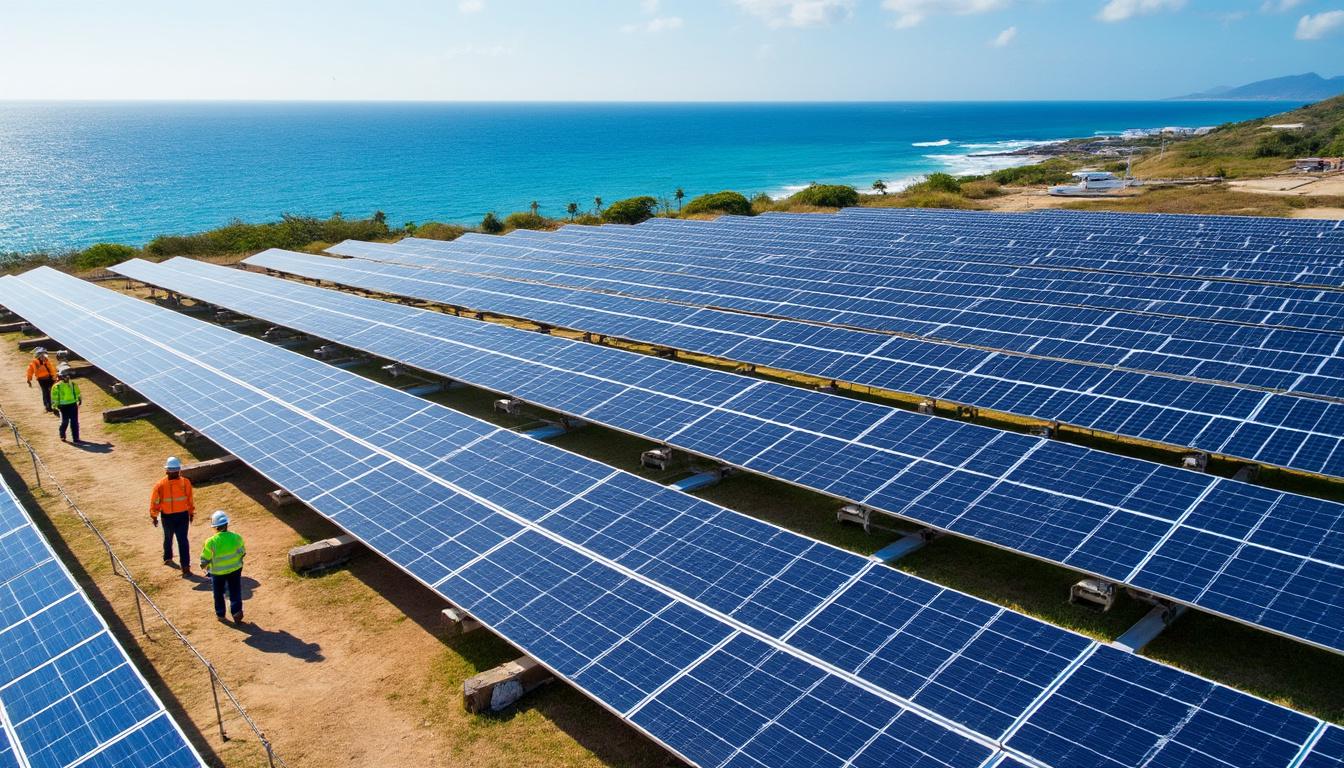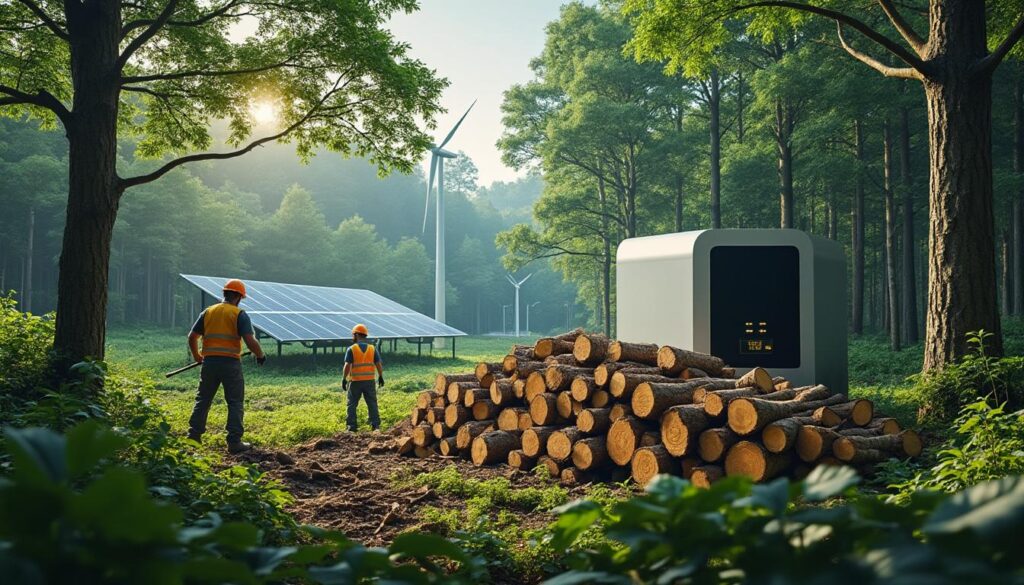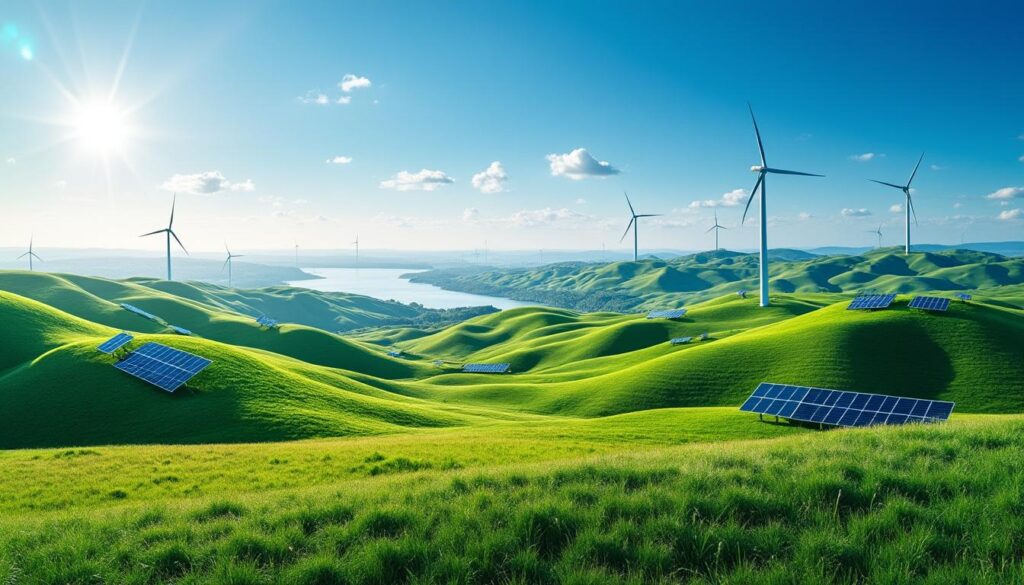Cape Verde accelerates the energy transition with a symbolic and practical step: the modernization of the Palmarejo solar power plant in Praia, as the first project financed through the debt conversion with Portugal. More than just construction, it is a new model of climate financing gaining shape and real impact.
| Short on time? Here’s the essential: |
|---|
| ✅ Repowering of Palmarejo: capacity increases from 4.4 MW to 10 MW ⚡, enough energy for 20,000–25,000 inhabitants 🏠 |
| ✅ Debt conversion supports Cape Verde’s Climate and Environmental Fund, active since July 2024 🌿 |
| ✅ Objective: invest where it reduces emissions the most — renewables, efficiency, agriculture, fisheries, and transport 🚍 |
| ✅ Outlook until 2030: expanded envelope to €42.5 million to accelerate projects with environmental and social returns 📈 |
Repowering of the Palmarejo Solar Power Plant: more clean energy for Praia
The contract for “Repowering of the Palmarejo Solar Power Plant” marks a decisive advance for the Cape Verdean capital. The operation increases the maximum capacity from the current 4.4 megawatts to 10 megawatts, thanks to the complete and systematic replacement of existing panels with more modern and efficient models, as explained by the Ministry of Energy. Practically, it means more production during peak hours, less loss, and better integration into Praia’s urban consumption profile.
With the reinforcement, the power plant will cover the equivalent energy consumption of 20,000 to 25,000 inhabitants, reducing the need for thermal generation and dependence on imported fuels. In archipelagos exposed to winds, salinity, and high radiation, repowering is not just about swapping modules; it requires corrosion-resistant design, electrical reconfiguration, and improvements in monitoring to maintain performance throughout the entire life cycle.
Why repowering is the right solution now
When infrastructure already exists, repowering brings quick gains: it reduces civil works costs, takes advantage of grid connections, and shortens timelines. In island projects, this reduces logistical risks and accelerates the delivery of benefits to the population. Besides module upgrades, interventions in cabling, inverters, and protection systems enhance safety and stability.
- 🔧 High-efficiency modules: more watts per square meter and better performance at high temperatures.
- 🌬️ Corrosion-resistant structures: anodized aluminum, stainless steels, and marine-treated fixations.
- 📡 String-level monitoring: rapid fault detection and preventive maintenance.
- 🛡️ Electrical protection: new surge protectors and safe disconnection.
- 🧭 Optimized layout: angle and spacing designed to reduce shading and maximize annual yield.
Expected outcomes and metrics that matter
In solar projects, quality is measured by capacity factor, PR (Performance Ratio), and availability. With state-of-the-art modules, a more stable PR throughout the day and better response in high irradiance scenarios is anticipated. Repowering also reduces operational costs per kWh and improves the LCOE, making solar electricity even more competitive.
| Indicator 🔎 | Before ⏳ | After 🚀 | Benefit 🌱 |
|---|---|---|---|
| Installed power | 4.4 MW | 10 MW | +127% useful capacity |
| Population equivalence | ~10–12 thousand people | ~20–25 thousand people | Greater coverage of urban demand |
| Panel replacement | Old models | High efficiency | More kWh per m² and per year |
| Monitoring | Point-in-time | String-level | Predictive maintenance ⚙️ |
By consolidating base production with solar energy, Praia gains resilience and room to integrate future solutions, such as storage and demand management. It is a solid step in a direction that has already proven effective.

Debt conversion into climate financing: how the mechanism works in practice
The great innovation lies in the financial mechanism. Cape Verde and Portugal agreed to convert part of the bilateral debt into climate investment, channeled into the Climate and Environmental Fund, approved by the Cape Verdean parliament in July 2024. In this model, debt payments are not forgiven: they are redirected, in a monitored manner, to projects that reduce emissions and reinforce climate adaptation.
During the January Summit in Lisbon, the envelope was expanded from €12.5 million to €42.5 million, with a horizon until 2030. The first concrete result is Palmarejo. The fund’s declared objective is to “mobilize and accelerate investments with significant climate and environmental impact”, measuring success by the amount of greenhouse gases avoided and the social co-benefits.
What makes this model replicable
For island countries with budget constraints, debt conversion opens fiscal space without compromising credibility. As resources are tied to eligible projects, there is governance and transparency. Besides renewables and efficiency, the fund can support agriculture, fisheries, and transport, creating a diversified portfolio resilient to shocks.
- 💼 No “pure” forgiveness: the financial flow meets obligations and delivers climate results.
- 🧭 Clear criteria: eligibility based on renewable kWh, kWh saved, and avoided CO₂.
- 🤝 Leverage: attracts co-financing from development banks and the private sector.
- 📊 Monitoring: auditable metrics and periodic reports.
- 🔁 Scalable: can extend to other Portuguese-speaking countries with local adjustments.
Phases, values, and governance
Throughout the process, amounts and scope were adjusted: €3.141 million was communicated for a modernization phase and approximately 1.5 million contos for the complete repowering and grid integration package, reflecting exchange rate evolution and expanded objectives. This clarification by phases is common in infrastructure projects, ensuring responsible execution.
| Milestone 🗓️ | Content 📌 | Value 💶 | Expected result 🌍 |
|---|---|---|---|
| Jul 2024 | Approval of the Climate and Environmental Fund | €12.5 million initial | Legal and operational basis |
| Jan 2025 | Program expansion at the Summit in Lisbon | Up to €42.5 million | Project pipeline until 2030 |
| Oct 2025 | Palmarejo contract (repowering) | Phase of €3.141 million → package of 1.5 million contos | +5.6 MW and higher PR |
| 2026–2030 | Scaling: efficiency, mobility, and cold chains | Phased execution | CO₂ avoided + green jobs 🧑🔧 |
Palmarejo is proof of concept. Once the environmental and social returns are demonstrated, the mechanism gains traction and inspires new bilateral and multilateral partnerships.
Impact for families and businesses: electricity bills, stability, and opportunities
More solar capacity in Praia translates into more stable electricity, lower exposure to fluctuations in diesel prices, and local job opportunities. For families, this means predictability in bills and a more reliable electrical system during peak consumption periods; for businesses, especially SMEs in fishing and tourism, greater competitiveness.
Let’s take a realistic example: the Monteiro Family, in an apartment in Achada Santo António, installed solar water heating and replaced bulbs with LEDs. With the cleaner and more efficient grid, consumption decreases and the rate becomes less volatile. Meanwhile, Atlântico Fresco Fish Market modernized its class A cold chambers and scheduled ice production during peak solar generation hours — a simple adjustment that reduces costs.
How to take advantage of the moment
With repowering, a window opens to optimize habits, minor constructions, and equipment. The benefit is twofold: savings and comfort. In neighborhoods exposed to heat and salinity, the combination of good ventilation, shading, and efficient appliances is unbeatable.
- 🏠 Home efficiency: LED, efficient fans, power strips with switches for standby loads.
- 🌞 Take advantage of the sun: schedule washing machines and water pumps during solar hours.
- 🪟 Smart shading: shutters, brises, and trees to reduce heat gain.
- 🧊 Efficient cooling: seek efficiency ratings and maintain sealing joints.
- 🔌 Tariffs and measurement: inquire about hourly rates and possible incentives.
Comparative case study
Comparing before and after helps visualize impact. Let’s consider a typical housing unit and an SME in food refrigeration that adopt simple measures and synchronize consumption with the solar production of the grid.
| Scenario 🧩 | Average monthly bill 💡 | Main action 🛠️ | Estimated effect 📉 |
|---|---|---|---|
| 2-bedroom apartment | — | LED + scheduling equipment | −10–15% in the bill with equal comfort 🙂 |
| 50 m² fish market | — | Class A cooling + ice during solar hours | −12–18% in energy costs 🐟 |
| Small hotel | — | Efficient showers + solar heating | −20% in hot water, lower night peak |
In practice, there are also new jobs in photovoltaic installation and maintenance, electrical inspections, and efficiency. Local businesses tend to grow with technical training aimed at operation in marine environments. When the grid becomes cleaner and more predictable, everyone benefits: families, businesses, and the electrical system as a whole.
Best practices for solar repowering in wind-exposed islands
The Ministry of Energy emphasized the complete replacement of panels with more efficient models. In the island context, there is a set of best practices that enhance durability and yield. Projects near the sea require solutions tested in saline mist, sudden winds, and high irradiance. Combining robust engineering with proactive maintenance prevents surprises and ensures performance for decades.
Design and right materials for the coast
Corrosion-resistant materials and quality fixations act as a kind of “technical insurance.” The design of the mounts should consider wind loads, avoiding vibration and loosening of screws. The wiring should have UV and saline protection, with routing that prevents water pockets.
- 🧱 Structures: anodized aluminum, A4 stainless steel, locking nuts, and controlled torque.
- 🧪 Certifications: IEC 61701 (saline mist), IEC 61215/61730 (modules), IEC 62109 (inverters).
- 🌡️ Thermal behavior: modules with a low temperature coefficient to maintain efficiency.
- 🌊 Sealing: original MC4 connectors and junction boxes with high IP ratings.
- 🧹 Cleaning: washing plan with demineralized water and anti-fouling schedule.
Electrical, monitoring, and operation
In addition to inverters sized for power peaks, surge protection and string-level disconnection are recommended. Granular monitoring speeds fault detection and reduces downtime. In areas with occasional shading, optimizers or microinverters can increase production.
| Best practices ✅ | Technical reason ⚙️ | Benefit 🟢 |
|---|---|---|
| Homogeneous strings | Minimizes mismatch between modules | More kWh/year |
| Surge protection | Mitigates damage from discharges | Higher availability |
| SCADA/monitoring | Real-time data | Predictive maintenance 📈 |
| O&M plan | Defined routines and KPIs | Extended lifespan |
In the end, repowering methodically ensures that every installed watt delivers maximum clean energy, with safety and durability. This is the standard that supports good results in Palmarejo.
Next steps: energy efficiency, mobility, and resilient agriculture
The Climate and Environmental Fund was designed to mobilize and accelerate investments with measurable environmental returns. Alongside renewables, there are three areas with rapid impact: energy efficiency in buildings, transport, and productive sectors such as agriculture and fisheries. The logic is simple: where more CO₂ is avoided per euro invested, the fund should act first.
In buildings, passive solutions — shading, cross ventilation, insulation at critical points — combined with efficient equipment can reduce cooling loads and electricity bills. In transport, electric bus corridors on urban routes and links to ports remove emissions from the streets and generate predictability. In agriculture and fisheries, solar cold chains and efficient pumping protect production, prevent losses, and sustain incomes.
Concrete ideas for the pipeline until 2030
Simple, replicable projects with clear result measurement make the fund more effective. By prioritizing actions with high energy and social ROI, Cape Verde consolidates a leadership trajectory among small island states.
- 🏢 Retrofit of public buildings: LED, smart control, and improvement of the envelope.
- 🚌 Electric shuttle Praia–ports–airport with solar charging.
- 🐟 Solar cold chain for artisanal fisheries, with local training.
- 🚰 Efficient pumping and PV-powered micro-irrigation.
- 🏡 Bioclimatic housing: shading, natural materials, and adequate ventilation.
| Project 📌 | Expected scale 📏 | CO₂ avoided/year 🌍 | Co-benefits 🤝 |
|---|---|---|---|
| Retrofit of 50 schools | 50 buildings | 1,200 t | Thermal comfort and learning 😊 |
| 10 electric buses | 2 urban lines | 1,000 t | Less noise and pollution |
| Community solar cold | 8 fishing hubs | 800 t | Less food waste 🐠 |
| Efficient pumping | 100 wells | 600 t | Guaranteed water and lower cost |
By uniting repowering, efficiency, and clean mobility, the country redefines its energy matrix with pragmatism and vision, enhancing autonomy and quality of life. If you want to delve deeper into efficient and affordable housing solutions, explore references and guides at Ecopassivehouses.pt, where you will find practical ideas to apply right away in your home.
Simple action for today: make a list of 3 efficiency measures you can implement at home this week — for example, replace bulbs with LEDs, schedule equipment for solar hours, and improve shading. Small pieces that, together, move the needle of consumption and comfort.
Source: observador.pt


